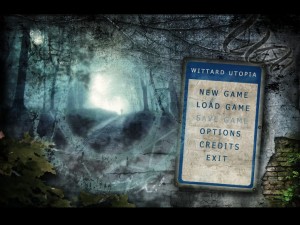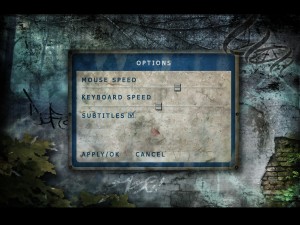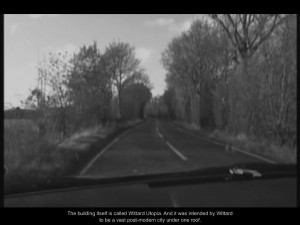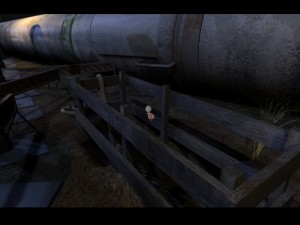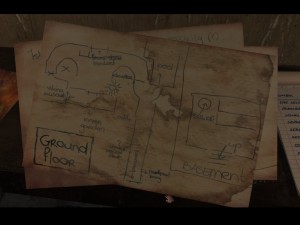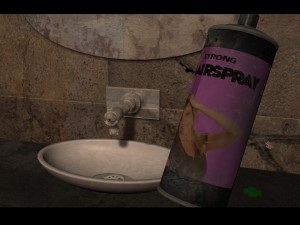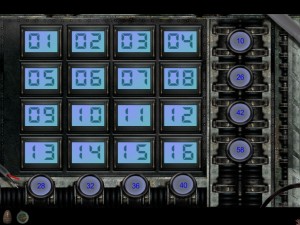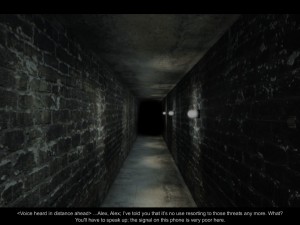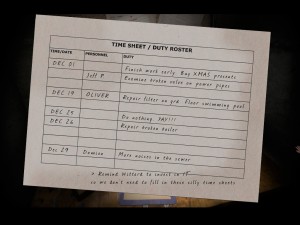The first horror adventure game that I remember playing as a kid was “7th Guest.” My memory is fuzzy on the subject, but I do remember wondering around a mansion, going from room to room, and attempting to solve these ridiculously hard puzzles. There was a spooky element to it all, but it didn’t make me scream like a little girl…something that Amnesia: The Dark Descent is want to do. I enjoy a good scare in the form of an interactive, horror adventure game, so I was happy to sit down with Baron Wittard: Nemesis of Ragnarok and give it a go. Before I get started taking a look at the game in detail, I’d like to thank Alan Thorn for sending me a free review copy.
The main menu screen is fairly straight forward…you’ll be able create a new game, load a saved game, adjust game options, and view the credits. It should be noted that I was unable to find a way to change the screen resolution in the options menu. It’s missing a lot of the basic options that I’d normally see, something I hope that can be addressed in a patch. For example, the options menu doesn’t address sound or video and only touches on mouse speed, keyboard speed, and subtitles.
Upon starting up a new game, we learn that Baron Wittard is an architect that created a monstrous city that happens to be inside a building…yeah, try wrapping your head around that. Before this illustrious work of art (called “The Utopia”) can be opened to the general public, a number of unfortunate somethings happen which cause it to remain closed and deserted. To make matters worse, electromagnetic disturbances and disappearances have been reported. Rather than send in the Ghostbusters, they’re sending you (a photographer) to discover the truth behind these strange occurrences.
The controls are simple in that all you’re doing is either using the mouse or keyboard to move around and interact with the environment. You won’t be able to control your movement with the WASD or arrow keys, but you’ll be able to pan the camera around and move to different parts of the environment by following the cursor prompts. This can serve to be both a blessing and a curse. While this movement scheme helps to narrow down how much you’ll actually have to explore, it eliminates that dreadful feeling I get in Amnesia when I’m forced to peek around a corner. There are also times where key objects can be selected in one part of an environment but not the other, making it almost necessary to explore each screen with a fine toothed comb.
Puzzles are varied and will certainly make you think. You won’t be able to breeze through this game in an hour, not unless you cheated and looked up the answers prior to playing. You’ll run into some familiar ones that involve chess pieces and sliding pictures while others are certainly unique in that I had no idea how to go about solving them until I gave them some serious thought. I recommend keeping a pencil and notepad handy as there are a few puzzles that will require you to remember numbers, shapes, and other tidbits of information. Much to my dismay, the game doesn’t offer an in-game journal to track the information that is lying around for you to find. The game leaves you on a non-linear path at times, so if you’re like me, you’ll end up wandering from room to room, trying to figure out what to do next. Patience is often said to be a virtue and those who have none may find themselves frustrated. One thing I’d like to see, besides an in-game journal, is a hint system that can be activated by the player, pointing them in the right direction without giving them the answer. Telltale did this with Back to the Future: The Game and it allowed me to progress steadily (and happily) when I hit bumps in the road.
In regards to atmosphere, this game has a lot of theme. A lot of detail went into the environment and there is plenty of things to look at, though I’m sorry to say that I didn’t find it to be all that scary. When my amulet wasn’t speaking to me, I was often just walking around trying to find either the next puzzle or the clues for one I had already run into. Lights flicker and the game does throw random noises at you on occasion, but I didn’t feel as if I was in any real danger. I did enjoy reading the notes and various papers I came across and I often found myself trying to work in those notes as clues to the puzzles I couldn’t solve. The voice acting was a bit…off, in my opinion. There were times where I had wished the scripted dialogue would end so that I could continue on to the next area.
Despite the lack of fear factor, Baron Wittard: Nemesis of Ragnarok is keeping me engaged with its challenging puzzles. Those going into this expecting their pants to be soiled may be disappointed, but those who enjoy an adventure story with puzzles will most likely come back for more. Jennifer, who enjoys seek and find puzzle games, commented that some of the puzzles she solves in her games are similar to those found in this one. She and I enjoyed working on some of those puzzles together and she even solved a few that had stumped me. If you’re someone who enjoys puzzle adventure games, then it wouldn’t hurt to give this a look.
Final Verdict: 5/10
—
You can learn more about Baron Wittard: Nemesis of Ragnarok by visiting this website:
You can help support it’s journey onto Steam by visiting its GreenLight page, here:
http://steamcommunity.com/sharedfiles/filedetails/?id=101747470&searchtext

